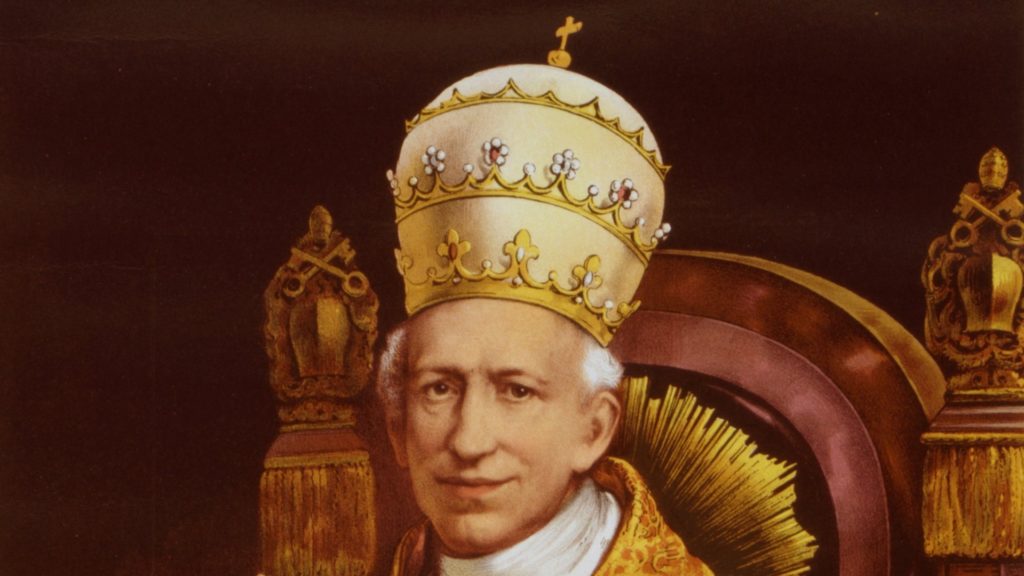In his May 10 address to the College of Cardinals, the newly elected pope explained the reason for the name he chose.
But first he paid homage to the Second Vatican Council and the ways in which the popes since St. Pope Paul VI have interpreted and applied the teachings of the council.
Then he brought it home: “Sensing myself called to continue in this same path, I chose to take the name Leo XIV … mainly because Pope Leo XIII in his historic encyclical ‘Rerum Novarum’ [‘Of New Things’] addressed the social question in the context of the first great industrial revolution.”
Now, he explained, the world faces “another industrial revolution and … developments in the field of artificial intelligence that pose new challenges for the defense of human dignity, justice, and labor.”
The last Leo, Leo XIII, ruled 1878-1903 and composed 14 letters that have been categorized as “social encyclicals.” The first, on socialism, appeared only 10 months after he took office. But his most famous, by far, was the letter mentioned this month by his successor: “Rerum Novarum, “which appeared in 1891.
Historians consider it to be the Magna Carta of modern Catholic social teaching. In it, Leo XIII surveyed the challenges brought on by industrialization. In discussing the dislocations of the preceding century, he critiqued both socialism and laissez-faire capitalism. He defended the rights of workers to just wages and adequate rest and to hold membership in labor unions. He upheld the right to private property. He exhorted governments to ensure that laws reflect the common good.
Through the century that followed, popes built upon the foundation of Rerum Novarum, acknowledging it frequently as their touchstone. “Quadragesimo Anno” was released by Pius XI in 1931, and its Latin title recognizes the “forty years” that have gone by since Leo’s “peerless encyclical on the condition of workers.” In the same way, Pope St. John Paul II’s “Centesimus Annus” marks the “hundredth year” since “Rerum Novarum.”
But the new pope, in 2025, has done something more than mark an anniversary. By choosing the name “Leo” and explicitly invoking “Rerum Novarum,” the Church’s 267th pope has placed not just an encyclical, but his pontificate, at the service of the social question. The Church and society have been placed on notice.
He alluded, however, to other, “different reasons” for choosing the name — and among them may be the character of the first pope to bear it.
Leo has signaled repeatedly his devotion to the early Church Fathers, especially St. Augustine of Hippo, the namesake of the pontiff’s religious order and the man from whom he chose his papal motto.
Augustine is among the few Fathers traditionally described as “the Great.” Another is Pope Leo I.
“Leo the Great” donned the papal crown in 440, just 10 years after Augustine had died at age 75, and he reigned as pope for 21 years. He was a self-effacing man, inclined to clarity and simplicity in speech. He left behind two volumes of letters and sermons, many thousands of words, rich in doctrine and counsel, but devoid of rhetorical flourish.
One thing is clear from all those words: he was profoundly influenced by St. Augustine. Stylistically, they could not be more different. Augustine was the greatest rhetorician of his age, and his sermons dazzled with all the tricks of his trade: rhyme, alliteration, repetition, riddles, and puns. Leo I, on the other hand, was simple and direct.
But Leo I was also quite clearly a close reader of Augustine. In homilies and sermons, he took his vocabulary from Augustine’s distinctive theology of the Trinity. In fact, he would sometimes lift sentences and paragraphs verbatim from the works of the late bishop of Hippo.
Leo I did this even in the text for which he is most famous — his “tome,” which summarizes the Church’s non-negotiable doctrine about the person and natures of Jesus Christ. The tome opposes the major heresies of the fifth century, Nestorianism and Monophysitism, and brings them down with words borrowed from Augustine. At the end of the document, Augustine is included, again, in an appendix of relevant biblical and historical testimonies. In fall of 451, Leo I sent the tome as his contribution to the Council of Chalcedon.
When the bishops there received it, they cried out: “Peter has spoken through Leo!” By acclamation they confirmed the dogmatic authority of Leo I’s tome, which had been delivered with apostolic authority, but cast in Augustine’s language.
Leo I may have been the first Augustinian pope, in the original sense of the word “Augustinian,” and even the first Augustinian pope named Leo.
It seems not too far a stretch to connect our modern Leo with the most ancient of his predecessors, as well as the most recent.

